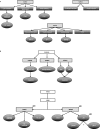Nervous NDRGs: the N-myc downstream-regulated gene family in the central and peripheral nervous system
- PMID: 31485792
- PMCID: PMC6754360
- DOI: 10.1007/s10048-019-00587-0
Nervous NDRGs: the N-myc downstream-regulated gene family in the central and peripheral nervous system
Abstract
The N-Myc downstream-regulated gene (NDRG) family consists of four members (NDRG1, NDRG2, NDRG3, NDRG4) that are differentially expressed in various organs and function in important processes, like cell proliferation and differentiation. In the last couple of decades, interest in this family has risen due to its connection with several disorders of the nervous system including Charcot-Marie-Tooth disease and dementia, as well as nervous system cancers. By combining a literature review with in silico data analysis of publicly available datasets, such as the Mouse Brain Atlas, BrainSpan, the Genotype-Tissue Expression (GTEx) project, and Gene Expression Omnibus (GEO) datasets, this review summarizes the expression and functions of the NDRG family in the healthy and diseased nervous system. We here show that the NDRGs have a differential, relatively cell type-specific, expression pattern in the nervous system. Even though NDRGs share functionalities, like a role in vesicle trafficking, stress response, and neurite outgrowth, other functionalities seem to be unique to a specific member, e.g., the role of NDRG1 in myelination. Furthermore, mutations, phosphorylation, or changes in expression of NDRGs are related to nervous system diseases, including peripheral neuropathy and different forms of dementia. Moreover, NDRG1, NDRG2, and NDRG4 are all involved in cancers of the nervous system, such as glioma, neuroblastoma, or meningioma. All in all, our review elucidates that although the NDRGs belong to the same gene family and share some functional features, they should be considered unique in their expression patterns and functional importance for nervous system development and neuronal diseases.
Keywords: Alzheimer’s disease; Cancer; Charcot-Marie-Tooth disease; Dementia; NDRG; Nervous system.
Figures



References
-
- Zhong C, Zhou YK, Yang SS, Zhao JF, Zhu XL, Chen HH, Chen PC, Huang LQ, Huang X. Developmental expression of the N-myc downstream regulated gene (Ndrg) family during Xenopus tropicalis embryogenesis. Int J Dev Biol. 2015;59(10–12):511–517. - PubMed
-
- Melotte V, Qu X, Ongenaert M, Van Criekinge W, De Bruine AP, Baldwin HS, Van Engeland M. The N-myc downstream regulated gene (NDRG) family: diverse functions, multiple applications. FASEB J. 2010;24(11):4153–4166. - PubMed
-
- Qu X, Zhai Y, Wei H, Zhang C, Xing G, Yu Y, He F. Characterization and expression of three novel differentiation-related genes belong to the human NDRG gene family. Mol Cell Biochem. 2002;229(1–2):35–44. - PubMed
-
- Ellen TP, Ke Q, Zhang P, Costa M. NDRG1, a growth and cancer related gene: regulation of gene expression and function in normal and disease states. Carcinogenesis. 2008;29(1):2–8. - PubMed
-
- Yao L, Zhang J, Liu X. NDRG2: a Myc-repressed gene involved in cancer and cell stress. Acta Biochim Biophys Sin Shanghai. 2008;40(7):625–635. - PubMed
Publication types
MeSH terms
Substances
LinkOut - more resources
Full Text Sources

